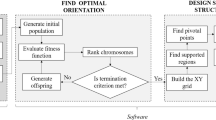Abstract
This paper proposes a novel design of machine bed used in laser, plasma and abrasive water jet (AWJ) cutting machines. During sheet metal cutting process, the laser/plasma beam pierces the sheet and further causes damage to the support bed. In contrast to the existing industrial practice of using fixed type support bed, the proposed adjustable pin type design bed adaptively provides support to the sheet by considering the parts layout that is being cut. In this design, the bed is formed with adjustable slats, in which the pins are inserted into the holes of the slats. By combining the dimensional data of machine bed and parts layout, an effective pin configuration is generated. The slats and position of the pins are represented in terms of genetic strings. The near optimal pin configuration is generated through a customized genetic algorithm. The objective is to minimize the damage caused by the tool to the bed and also to provide effective support to the different geometrical parts based on its centroid location. The effectiveness of the proposed approach is tested by combining the data of the bed and its different parts of the layout with irregular geometries. The results are promising and the uniqueness of the proposed approach is illustrated with different test cases.














Similar content being viewed by others
References
Anand, K. V., & Babu, A. R. (2015). Heuristic and genetic approach for nesting of two-dimensional rectangular shaped parts with common cutting edge concept for laser cutting and profile blanking processes. Computers & Industrial Engineering, 80, 111–124.
Babu, A. R., & Babu, N. R. (1999). Effective nesting of rectangular parts in multiple rectangular sheets using genetic and heuristic algorithms. International Journal of Production Research, 37(7), 1625–1643.
Bowman, M. (2014). Sheet metal work—Crowood Metalworking Guides. Marlborough: The Crowood Press Ltd.
Buchfink, G.(2006). Fascination of sheet metal: A material of limitless possibilities.,1st edn. Vogel Buchverlag, Würzburg.
Chaki, S., Bathe, R. N., Ghosal, S., & Padmanabham, G. (2015). Multi-objective optimisation of pulsed Nd: YAG laser cutting process using integrated ANN–NSGAII model. Journal of Intelligent Manufacturing. doi:10.1007/s10845-015-1100-2.
Fagan, M. (2008). Method and system for eliminating external piercing in NC cutting of nested parts. United States patent US, 7,469,620.
Goldberg, D. E. (2014). Genetic algorithms in search, optimization and machine learning. New Delhi, India: Dorling Kindersley (India) Pvt. Ltd.
Hayasi, M. T., & Asiabanpour, B. (2013). A new adaptive slicing approach for the fully dense freeform fabrication (FDFF) process. Journal of Intelligent Manufacturing, 1–12.
Karagöz, S., & Yıldız, A. R. (2017). A comparison of recent metaheuristic algorithms for crashworthiness optimisation of vehicle thin-walled tubes considering sheet metal forming effects. International Journal of Vehicle Design, 73(1–3), 179–188.
Karen, I., Yildiz, A. R., Kaya, N., Öztürk, N., & Öztürk, F. (2006). Hybrid approach for genetic algorithm and Taguchi’s method based design optimization in the automotive industry. International journal of production research, 44(22), 4897–4914.
Kiani, M., & Yildiz, A. R. (2016). A comparative study of non-traditional methods for vehicle crashworthiness and NVH optimization. Archives of Computational Methods in Engineering, 23(4), 723–734.
Leung, T. W., Yung, C. H., & Troutt, M. D. (2001). Applications of genetic search and simulated annealing to the two-dimensional non-guillotine cutting stock problem. Computers & Industrial Engineering, 40(3), 201–214.
Nye, T. J. (2000). Stamping strip layout for optimal raw material utilization. Journal of Manufacturing Systems, 19(4), 239.
Onwubolu, G. C., & Mutingi, M. (2003). A genetic algorithm approach for the cutting stock problem. Journal of Intelligent Manufacturing, 14(2), 209–218.
Weeks, T. R., Lopez, R. R., Burgardt, J. J., & Hoffman, D. J. (1993). U.S. Patent No. 5,227,606. Washington, DC: U.S. Patent and Trademark Office.
Yildiz, A. R. (2013). Comparison of evolutionary-based optimization algorithms for structural design optimization. Engineering Applications of Artificial Intelligence, 26(1), 327–333.
Yıldız, A. R., Kurtuluş, E., Demirci, E., Yıldız, B. S., & Karagöz, S. (2016a). Optimization of thin-wall structures using hybrid gravitational search and Nelder–Mead algorithm. Materials Testing, 58(1), 75–78.
Yıldız, B. S., & Lekesiz, H. (2017). Fatigue-based structural optimisation of vehicle components. International Journal of Vehicle Design, 73(1–3), 54–62.
Yildiz, B. S., Lekesiz, H., & Yildiz, A. R. (2016b). Structural design of vehicle components using gravitational search and charged system search algorithms. Materials Testing, 58(1), 79–81.
Yildiz, A. R., & Saitou, K. (2011). Topology synthesis of multicomponent structural assemblies in continuum domains. Journal of Mechanical Design, 133(1), 011008.
http://www.trumpf-machines.com/fileadmin/DAM/trumpf-machines.com/Ueber_TRUMPF/Mediathek/Bibliothek/Library_Laser_Laser_Cutting.pdf. Accessed Jan 11, 2017.
Author information
Authors and Affiliations
Corresponding author
Rights and permissions
About this article
Cite this article
Anand, K.V., Udhayakumar, S. Design of adaptable pin configuration machine bed optimized with genetic approach for sheet metal cutting process. J Intell Manuf 30, 1319–1333 (2019). https://doi.org/10.1007/s10845-017-1327-1
Received:
Accepted:
Published:
Issue Date:
DOI: https://doi.org/10.1007/s10845-017-1327-1




